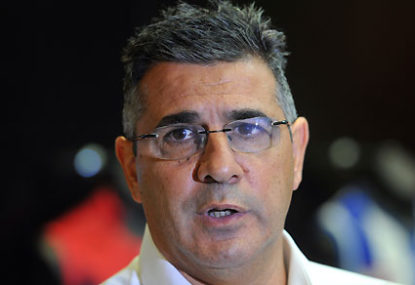J.Schanssema
new author
Roar Rookie

The financial health of our beloved sporting code has never been better. Record crowd attendances, TV audiences, memberships and a bumper TV rights deal.
But there has been a negative side effect to the way the AFL has managed and built the game: the loss of club culture.
Club culture has been slowly eroded over the last 25 years as the top brass in the AFL has reshaped and remodelled our clubs’ identities.
We have seen it all before in American and European sporting codes and leagues. We have seen the way money has changed the representation and essence of sporting clubs to resemble something more of a brand or a fashion label.
Barcelona FC, The Los Angeles Lakers, Manchester United. All these powerhouse sporting clubs have the same hallmarks of universal branding, marketing and the creation of an icon. But for all the bravado, show pony and elitism that these clubs ooze, there is still something that keeps these clubs a club.
Their home ground.
As massive as the Manchester United brand has become, each time we tune into them playing a home game at the “Theatre of Dreams” with their loyal members, we are reminded that this iconic sporting label is still a football club at its heart.
The club pays homage to its sons of old and past glories every time the players step onto the famous turf. For all the politics, the buyouts, the multi-million dollar deals, the Red Devils still do their dirty work at their old happy hunting ground in front their fan-base.
The LA Lakers still get to step onto the famous checkered floor of Boston Garden to play their old rivals. The Yankees host the Mets and the Bulls visit Madison Square Garden. In our own city, the home of AFL footy, the Melbourne Heart and Melbourne Victory, with barely 10 years history between them, enjoy a cross town rivalry between their two respective home grounds.
But in the AFL, Essendon, a 141-year old club with the most premierships in AFL history plays its home games in a 12-year-old ‘multi purpose’ stadium in a suburb known as Docklands.
The ground is shared between four other rival clubs, including arch rival Carlton.
To the east, the most supported club in the league, Collingwood, has its training facility in East Melbourne which is branded the Westpac centre.
The club’s spiritual home, Vic Park, has been almost completely bulldozed.
When you rob a sporting club of its home ground, you take away a part of who and what that club is.
The AFL has moved with great haste to create a professional, state-of-the-art round robin competition, using famous, fiercely supported and proud football clubs as its springboard.
We travel to the multi-purpose stadium with its roof closed to watch a sport played outdoors at every other venue.
We turn on Friday night footy wondering which is the home team. We see a game switched to an alternate venue which is the ‘home’ ground for the away team.
The R.S Reynolds and Allan Hird stands have been replaced at Essendon home games with a makeshift placard at the multi purpose stadium saying Lloyd End and Fletcher End. Which in itself, is a mockery of the actual names given to each end, Lockett and Coventry.
We debate away-strips and clash guernseys with such passion and gusto, but barely a cursory mention is made of the demise of Windy Hill, Victoria Park, Princess Park, or even Waverley.
In this day and age, where the almighty dollar rules all, we need to be careful just how far we want to make this sport about money, and not about passion.
When you focus on branding and marketing, you expand the club as a viable entity. But when its home is lost, a large piece of what that club is goes with it.
Now I’m not saying we should build 10 Etihad Stadiums. God forbid.
But instead of spending $460 million back in 2000 to build ES, we could have invested $100 million dollars or so at four or five suburban grounds. We could have invested the money back in the clubs. \
Instead we put all our eggs into one odd, awkward multi-purpose basket where clubs share tenancy like a boarding house.
Imagine Collingwood being able to host Port, North, St Kilda and the interstate clubs for true home games at a 45,000 seat capacity Vic Park, or Essendon doing similar at Windy Hill and Carlton at Princess Park.
Imagine a league where gate receipts were returned to the clubs in their entirety, instead of being divided up among the corporates and the AFL honchos.
Imagine giving the Victorian clubs the opportunity for a bit more business sense and control of their destiny, the likes of which Geelong are currently pioneering through their investment and home matches at Kardinia Park.
Imagine wrestling some of that unnecessary financial control off the AFL through the tenancy stadium system, as well as its crude drip feed of payouts to the smaller clubs subject to their terms and conditions.
Imagine a league where Essendon and Collingwood get to enjoy a home ground of their own, the way the Greater Western Sydney Giants (est 2011) and the Gold Coast Suns (est 2009) get to have one.
Progress is inevitable, but even the European and American hob knobs of sport knew not to mess with a clubs spiritual home and playing arena.